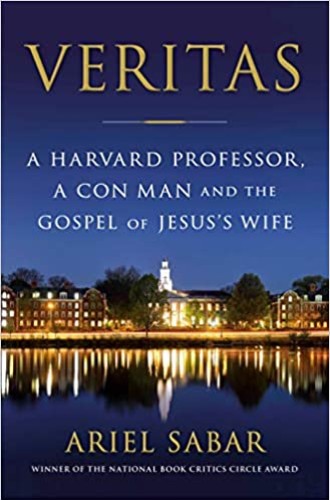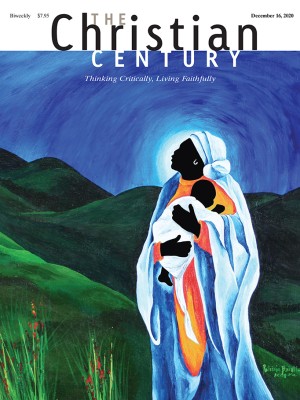A religious studies thriller about Karen King’s “Gospel of Jesus’ Wife”
Ariel Sabar’s nonfiction book contains more twists and turns than a car chase.
Typically one would not need to offer a spoiler alert for the review of a nonfiction book about an academic dispute, but this is an exception. Ariel Sabar’s book—with its portentous title and tabloid-style subtitle—reads like a thriller. The plot features more twists and turns than a car chase, although, for the most part, this one unfolds in slow motion. There is an element of international intrigue and even a dash of lurid sex. The colorful characters are portrayed so vividly that I started mentally casting some of my favorite character actors to play various roles in a movie version.
The story begins with a scholar and a text. On April 10, 2014, Harvard Divinity School announced that one of their star faculty members, Karen King, had obtained a papyrus fragment. She called it “The Gospel of Jesus’s Wife” because it included the phrase “Jesus said to them, ‘My wife . . .’” Written in Coptic, the fragment was not much larger than a business card, and the tantalizing reference to Jesus’ wife was cut off mid-sentence. The announcement heralded the papyrus as the first ancient manuscript to indicate that Jesus was married—or, at least, that some early Christians thought he was.
Read our latest issue or browse back issues.
Karen King is the Hollis Professor of Divinity at Harvard—the oldest endowed chair in the country—and a widely respected scholar. Coinciding with the announcement, King published an article on the papyrus in the Harvard Theological Review, lending it added credibility. Besides, the papyrus had been examined by other scholars, and its age had been determined using scientific methods. What could go wrong?
The story immediately became front-page news around the world. Television evening news programs covered the story, and the Smithsonian Channel released a documentary. Almost immediately, people inside and outside the academy began to make assertions about how this discovery might prompt a reexamination of everything from the celibacy of clergy to the role of women in the church.
Dan Brown’s 2003 blockbuster novel The Da Vinci Code raised similar questions by putting a Harvard professor at the center of its narrative and positing that Jesus was married to Mary Magdalene. King served as a consultant for the 2006 film adaptation of the novel, although she was careful not to associate her scholarly work too closely with Brown’s fictional work. Millions of readers and moviegoers were drawn to Brown’s portrayal of the “sacred feminine.” One could only imagine how the public would respond to a work of scholarship reflecting some of the same themes—coming from Harvard, no less.
But then—spoiler alert—the papyrus was found to be a forgery. Scholarly consensus on that point was reached only weeks after the announcement of the discovery, which calls into question the process by which a respected scholar and a prestigious theological journal could have concluded otherwise.
King never revealed who gave her the papyrus; she had assured the donor that he would remain anonymous. But Sabar does his own detective work, and it leads him to the con artist who targeted Harvard, and King in particular, for his ruse. Walter Fritz did not have any scholarly credentials, just a forged diploma in Egyptology. He lived in a trailer in central Florida and pieced together a living through various jobs and endeavors, including a pornography website that featured his wife having sex with other men.
King failed to investigate Fritz’s background or credentials, and she showed an astonishing lack of interest in the provenance of the papyrus she was introducing to the world with such fanfare. When the papyrus was revealed as a forgery, she made the disingenuous claim that she had not been aware that provenance can be investigated.
Sabar shows that King is not the only one responsible for this fiasco. The peer review system at the Harvard Theological Review, through which scholarly articles are vetted by anonymous and disinterested scholars in the field, broke down in several ways. Some scholars raised serious doubts about the authenticity of the papyrus, but other reviewers, close colleagues of King’s, prevailed, sometimes using pretzel logic. For instance, they granted that the papyrus was written in ungrammatical Coptic and with the unsteady penmanship one might expect from a child. It is highly doubtful, one reasoned, that a forger would ever be that sloppy. No one seemed to consider the possibility that it was just a bad forgery.
Further, little consideration was given to the possibility that a reference to “my wife” by Jesus might reflect the tradition of referring to the church as the bride of Christ. Or the sentence might have taken another turn entirely. As Jon Stewart quipped on The Daily Show, “That’s your proof? Well, let me see if I can fill that sentence out for you: Jesus said, ‘My wife, if I ever have one.’”
Sabar spins out the narrative with skill, letting the revelations unfold for his readers as they did for him. Sometimes his writing sounds as breathless as Brown’s. (“Front and center on King’s papyrus were two lines so full of firepower they could almost be bullets.”) Other times the prose turns purple, as with the wave of alliteration with which he describes the appeal of the papyrus to King: “a lullaby that filled a long-lamented lacuna.”
But these are mere quibbles. Sabar is a gifted writer who has conducted careful research, leaving one to wonder all the more why his subjects did not do the same.
Sabar offers a number of possible reasons why King and her colleagues did not, in this instance, follow the rigorous disciplines and practices of scholarship. The simplest explanation, and the one I find most compelling, is confirmation bias—the human tendency to interpret new evidence in a way that confirms opinions already held.
My next-door neighbor read Veritas in a matter of days. She was drawn in by the narrative, but she was ultimately disappointed in the conclusion. She said of the notion that Jesus was married, “I just so wanted it to be true.”
Clearly, a lot of other people did, too.







